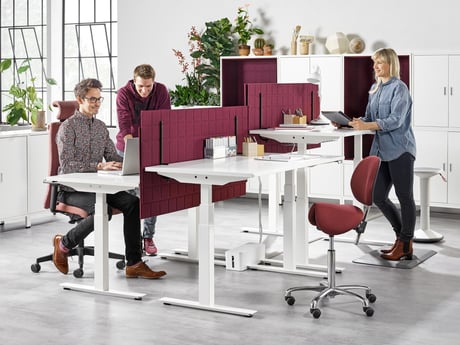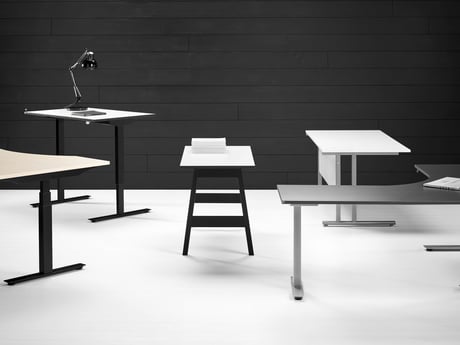How to choose the right office chair

How many hours a day do you spend sitting at your desk? Research shows 81% of UK office workers spend 4-9 hours sitting down every day. Sitting for long hours can lead to back pain and musculoskeletal problems. It’s essential to have an office chair that will give you the right support and help you sit in an ergonomic position rather than exacerbating the problem.
However, with such a huge range of chairs available on the market, it is hard to tell a good office chair from a bad one. Some of it comes down to personal preference but there are certain features that will help you select a good quality ergonomic chair that can be adjusted to your needs.
What features should you look for in an office chair?
Adjustability
Seat height: You should always be able to adjust the height of your chair easily. Most office chairs come with a gas-lift mechanism for adjusting the height. You want to be able to place your feet flat on the floor when your back is against the backrest.
Backrest height: You want to be able to adjust the height of the backrest so that you can align the backrest with the natural curvature of your spine.
Backrest and seat angle: This is controlled by the type of mechanism the chair has. There are four main types of mechanism (from least to most adjustable): permanent contact back (PCB), lock-tilt, synchronous or asynchronous. The best mechanisms give the user the most control over their position and will allow you to adjust both the seat and backrest angle; look for a mechanism that allows you to fix your chair into a number of positions or leave it in free float to follow your movements (check out our glossary below for more details).
Seat depth: This is adjusted with a seat slide mechanism and is particularly important for taller people. You should be able to sit with your bottom against the back of the chair and place two or three fingers between the front of the chair and the back of your knees.
Armrests
Armrests should allow your arms to rest comfortably with your elbows at a 90° angle and your shoulders relaxed. Adjustable armrests are the best choice as they allow you to set a position that suits your height.
Lumbar support
The right ergonomic chair will alleviate any pain in the lower back, or lumbar region, by providing support for the natural S-shaped curve of the spine. A well-padded curved backrest will provide some relief, but the best office chairs have a lumbar pump that lets the user inflate the backrest to suit their body. This feature combined with a height adjustable backrest will ensure the lumbar support is exactly right for you.
Swivel function
It may sound obvious but a swivel function is essential so that you can easily reach different areas of the desk without straining.
What’s the best sitting position?
Finding the right chair will help you sit in the most ergonomic position. Remember that buying a chair is not a case of one-size-fits-all, different chairs suit different people.
- With your bottom pressed against the back of the chair, your feet should be able to rest flat on the floor.
- There should be about an inch of space between the seat and the back of your knees when you sit back against the chair.
- Your knees should be bent at a right angle with your knees in line with your hips.
- Your forearms should rest on the armrests with your shoulders relaxed.
- The backrest should be high enough to support the entire back. At a minimum, the top of the backrest should reach the middle of the shoulder blades.
What does it all mean?
Glossary
Asynchronous: allows you to independently adjust the tilt of the seat and backrest, which can then either be fixed in the most comfortable position or left to follow your movements (free float).
Lock tilt: single lever mechanism allowing you to lock or unlock the tilt of the seat and back, which move in direct relationship with each other. The chair position can be locked in position or left in free float.
PCB (permanent contact back): the seat and the back are height adjustable; you can fix the angle of the backrest or leave it in free-float, i.e. in permanent contact with your back.
Synchronous: allows you to adjust the angle of the backrest and seat together - usually in a ratio of 2:1- and then either fix the position or leave in free float.
Weight torsion control: adjusts the chair’s mechanism to the user's body weight to ensure that the seat reclines smoothly and that resistance when in free float suits the user.
What other options are available?
Even with the best ergonomic chairs on the market, there are still health concerns about the number of hours spent sitting down. If you worry that you are sitting too much, consider the alternatives.
Active sitting
Unlike a normal office chair, an active chair keeps your body moving while you sit by encouraging the same natural shifts in posture that occur when standing or walking. To stay balanced on the stool you must constantly readjust your sitting position, which improves posture, reduces stress on the body and strengthens back and core muscles.
Sit-stand desks
Sit-stand desks allow you to switch your position from sitting to standing throughout the day so you avoid the health concerns associated with sitting for long hours. Standing up for just three hours a day every day burns 750 calories a week and is the equivalent of running about 10 marathons a year!


